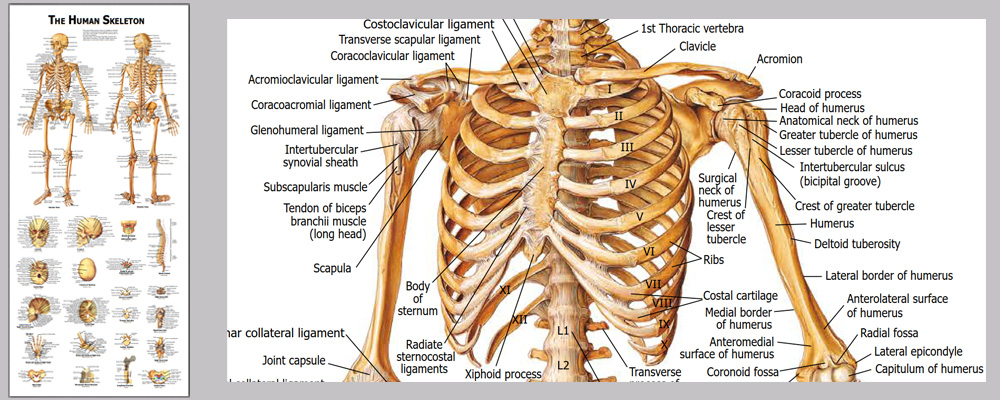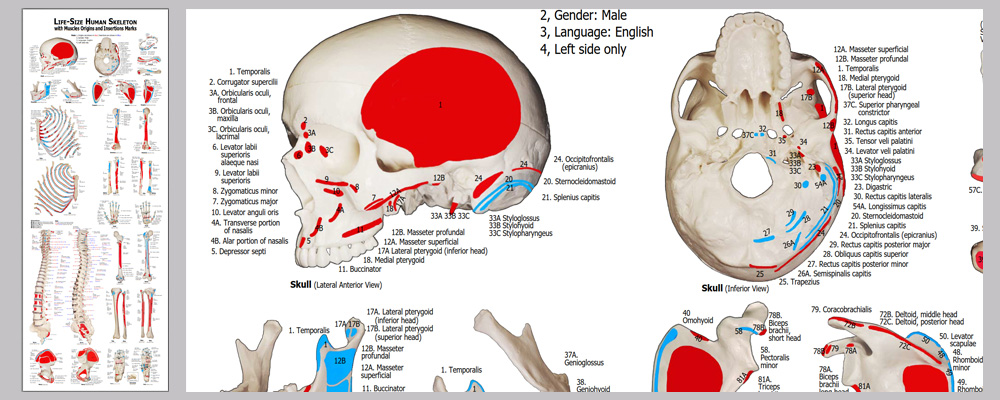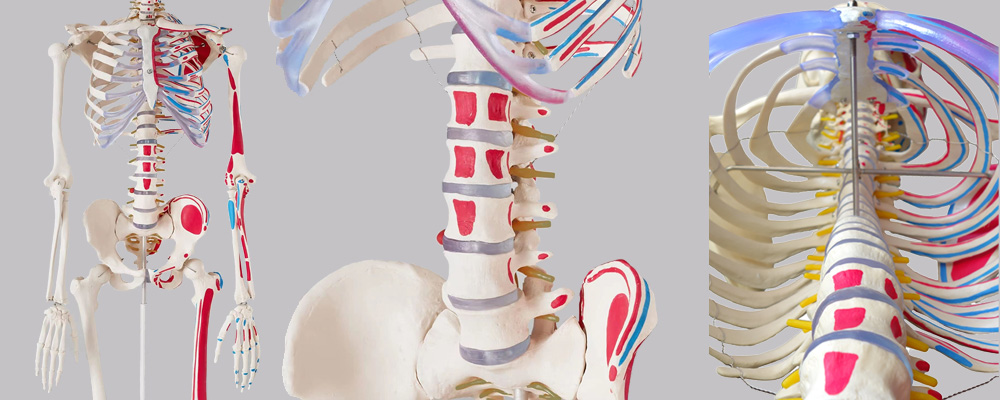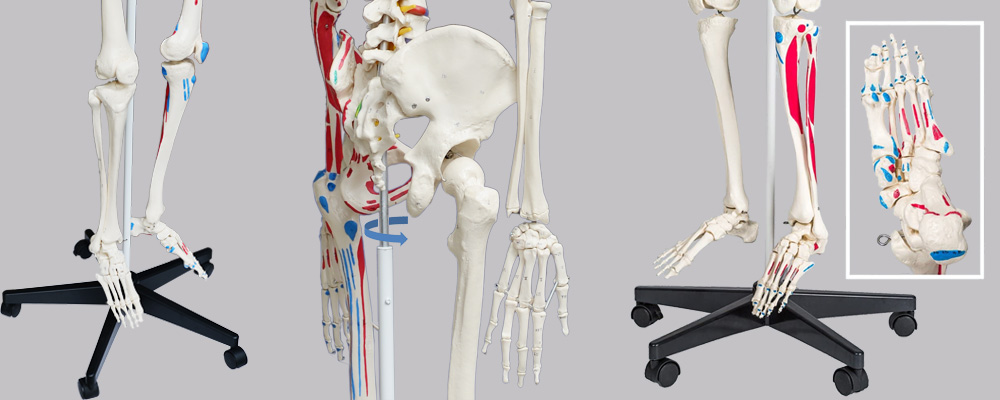human skeleton model
This life size articulated adult human skeleton model is 180cm tall & ideal for teaching / learning the basics of human anatomy. Includes a colorful Human Skeleton chart to show all the detailed structures for reference.Detailed colorful chart with over 630 accurate definitions. Durable and no reflection with matte film covered, 36 * 78cm

Detailed muscles origins and insertions with codes. Durable and no reflection with matte film covered, 100cm * 38cm

Stainless steel wires keep the ribs gaps stable.

2 of 5 casters are lockable.

With JC anatomy, you can also demonstrate the movements of the skull via the head joints, and thanks to the fully flexible spine, you can adjust the human skeleton model to place it in natural body postures. The unique combination of muscle origins and insertions, the numbered bones, flexible ligaments and flexible spine with a slipped disc between the 3rd and 4th lumbar vertebrae clearly the show medical and anatomical interest of this top model's more than 650 structures. Now available on a stable metal stand with 5 casters!
| Product name | human skeleton model |
| Place of Origin | Shenzhen China |
| Product Material | PVC, ABS, SST |
| Rib cage | A 5mm dia |
| Human skeleton model life | 17years |
| Surface treatment | Polish. Etched. Texture |
| SUPPORT 24/7 | Contact us 24 hours a day, 7 days a week |
| Size | 72 * 46 * 147 |
| Port | Shenzhen |
| PAYMENT & ORDERING | PayPal account or pay by credit card |
human skeleton model FAQs Guide Are you looking for a quick review guide about human skeleton model? An ultimate FAQs buying guide is available to help you.This guide contains all the information about all the important facts, figures, and various processes regarding human skeleton model. Let’s continue!
2.Does this human skeleton model include all human skeletal systems?
3.About the scale of human skeleton model factory
4.Can this human skeleton model be used as a simulation tool for sports training?
5.About human skeleton model payment method
6.About human skeleton model raw materials
7.Can human skeleton model be used in medical research?
8.How can a human skeleton model be utilized for rehabilitation and physiotherapy purposes?
9.About human skeleton model production capacity
10.How much does it weigh and is it easy to carry and maneuver human skeleton model?
11.Is it possible to display muscle tissue on human skeleton model?
12.human skeleton model Can it be used as a teaching aid?
13.What are the different types of human skeleton model available?
14.Does the human skeleton model have movable joints that can show the range of motion of various parts of the human body?
15.Can bone diseases such as osteoporosis be displayed on the human skeleton model?
1.Does the manufacturer of this human skeleton model provide relevant anatomy teaching materials?
Yes, we provide a series charts to support teaching and learning
2.Does this human skeleton model include all human skeletal systems?
It depends on the model in question. Some Human skeleton models may include all human skeletal systems such as the axial skeleton (skull, vertebral column, ribcage), appendicular skeleton (arms, legs, shoulder girdle, pelvic girdle), and cartilaginous skeleton (cartilaginous structures such as the nose and ears). However, others may only include certain systems or be limited to specific areas of the body. It is important to carefully read the product description or ask the manufacturer for a detailed list of what is included in the model to ensure that it meets your needs.
3.About the scale of human skeleton model factory
Covering an area of about 2000 m². This would include manufacturing space for assembly, molding, and finishing processes, as well as storage space for raw materials and finished products.
4.Can this human skeleton model be used as a simulation tool for sports training?
The Human skeleton model can definitely be used as a simulation tool for sports training. This model can be used in various ways to simulate different scenarios and movements that are specific to different sports. In conclusion, the Human skeleton model is a versatile tool that can be used to enhance sports training in various ways. It can help athletes and coaches understand and improve technique, prevent injuries, analyze and correct movement patterns, and simulate specific sports movements and scenarios. Thus, it can be a valuable resource for individuals looking to train and improve their performance in sports.
5.About human skeleton model payment method
TT, or Paypal
6.About human skeleton model raw materials
PVC, ABS, SST
7.Can human skeleton model be used in medical research?
This model is mainly for displaying the skeleton structure, shapes, position relationship, and simulating joints movements, surface texture of the bones.
8.How can a human skeleton model be utilized for rehabilitation and physiotherapy purposes?
Demonstrate the right bone parts postion relationships can help doctors and patients to understanhuman skeleton model can be a valuable tool for rehabilitation and physiotherapy purposes as it can aid in teaching and demonstrating proper body mechanics, identifying and addressing musculoskeletal imbalances and dysfunctions, and monitoring progress in treatment. Here are some ways in which a human skeleton model can be utilized for rehabilitation and physiotherapy purposes: 1. Education: A human skeleton model can be used to educate patients and clients about the structure and function of the human body. This can help them understand their injuries or conditions better, and also make them more aware of how their body moves and functions. 2. Creating personalized treatment plans: With the help of a skeleton model, therapists can design personalized treatment plans for each individual patient. This can include exercises and movements targeted at specific areas of the body that need strengthening or stretching.d the right way of rehabilitation and physiotherapy.
9.About human skeleton model production capacity
600pcs each month
10.How much does it weigh and is it easy to carry and maneuver human skeleton model?
The Net weight is 8.8kgs (19.4lbs). It's easy to move with the 5 castors
11.Is it possible to display muscle tissue on human skeleton model?
This model was not built with muscle tissue. But you can display the muscle tissue by putting it on the appropriate positions of the model.
12.human skeleton model Can it be used as a teaching aid?
Yes, a human skeleton model is a commonly used teaching aid in various academic fields such as anatomy, biology, and medical education. It is an accurate and detailed representation of the human skeleton, providing a visual aid for students to understand and grasp the complexities of the skeletal system.
13.What are the different types of human skeleton model available?
1. Anatomical Skeleton Models: These models are exact replicas of the human skeletal system and are used for educational and medical purposes. They are typically made of high-quality materials such as plastic or resin and come with detailed labels for each bone, making it easy to identify and study different structures. 2. Disarticulated Skeleton Models: These models consist of individual bones that can be separated from each other. They are often used in classrooms for teaching purposes as they allow students to handle and study each bone individually, facilitating a more hands-on learning experience. 3. Flexible Skeleton Models: These models are made from a flexible material such as rubber or PVC and are designed to mimic the movements of the human body. They are often used in medical training and rehabilitation settings to demonstrate muscle and joint movements. 4. Life-size Skeleton Models: As the name suggests, these models are the same size as an actual human skeleton. They are most commonly used in medical schools and hospitals for teaching and training purposes.
14.Does the human skeleton model have movable joints that can show the range of motion of various parts of the human body?
Yes, the human skeleton model typically has movable joints that can show the range of motion of various parts of the human body. These joints are usually represented by different types of articulations such as ball and socket, hinge, saddle, pivot, and gliding joints, which mimic the movement of the actual joints in the human body. For example, the shoulder joint of a human skeleton model will have a ball and socket structure that allows for a wide range of motion, similar to the shoulder joint in a real human body. This joint is able to rotate 360 degrees and can also move forward, backward, and sideways. Similarly, the elbow joint in a human skeleton model will have a hinge structure that allows for flexion and extension movements, just like the elbow joint in a real human body. This enables the model to accurately demonstrate movements such as bending and straightening of the arm.
15.Can bone diseases such as osteoporosis be displayed on the human skeleton model?
Yes, bone diseases like osteoporosis can be displayed on a human skeleton model. A human skeleton model is a representation of the bones and joints of the human body and can be used to educate and train students and medical professionals. Osteoporosis is a bone disease that results in weakened and porous bones, increasing the risk of fractures. As a result, there are certain features and changes in the bone structure that can be seen on a human skeleton model.




